What we do
Services
Experts in
As you glance through your calendar on your phone, set an alarm for tomorrow, order food, or request an Uber ride, you’re using custom software.
Behind every app on your phone, the browser you use on your laptop, and even the automatic gate at your parking lot are many lines of code that make everything possible. With the right software, you can manage your tasks, organize your routine, and book tickets to your favorite destination. With the right software, you can manage your business, increase sales, reduce costs, improve the customer journey and customer service, save time and effort of your employees, and deal with many other tasks.
Do you have an idea in mind for a custom software solution? Then you’ve come to the right place. As a software product development company, we have extensive experience turning unique ideas into robust, effective solutions that drive business growth and efficiency.
In this article, you’ll learn everything you need to know about custom development: what it is, advantages of custom software, key development stages, and many related details that will help you not only increase your awareness of custom products for your business but also launch your own solution.
First of all, let’s have a quick look at the key concept we’re going to talk about in this article: custom software.
Imagine a world where all the products and services you access are one-size-fits-all. You can’t buy groceries you like; you can’t buy your favorite coffee; you can’t even buy a coat in your size because everything in stock is of a single type, roast, size, fabric, etc.
That would be a world of zero diversity and complete indifference to real customers’ needs and wishes.
But the adjective custom changes everything. As soon as you start creating goods for particular people, you cater to particular needs, satisfy buyers’ wishes, and succeed as a manufacturer.
Now, let’s apply this principle to software.
Custom software is developed to meet specific, well-defined needs of the target audience. It aims to satisfy these needs and generate monetization opportunities for software owners.
Custom software can bring value to customers, attract investments, and increase any company’s revenue.
For over 30 years, the most successful companies in the tech market have kept on proving this, and forecasts suggest that this tendency isn’t going to change:
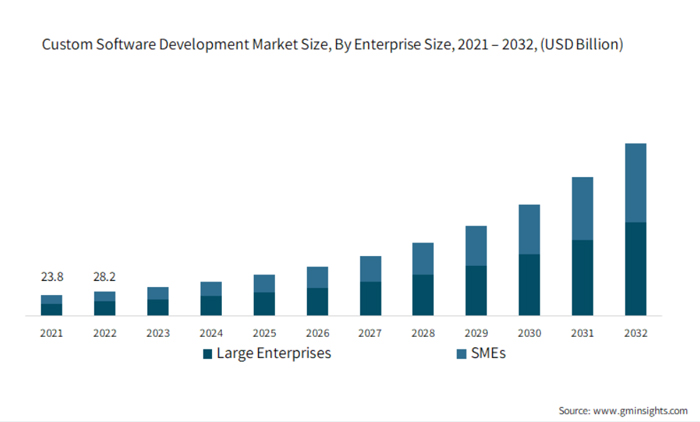 With all the technologies that are advancing faster than we could imagine, and the fantastic potential of large language models, businesses have the chance to reach their goals, adjust their products and services to existing needs, and raise investments with the right custom software solutions.
With all the technologies that are advancing faster than we could imagine, and the fantastic potential of large language models, businesses have the chance to reach their goals, adjust their products and services to existing needs, and raise investments with the right custom software solutions.
Now, what does it take to make it happen?
All of the money poured into tech companies in the first half decade of the Internet Era created an infrastructure and economic foundation that would allow the Internet to mature.
The maturity of internet technologies and the tremendous number of development tools that have been developed and perfected over the past 20 years have created perfect conditions for successful web development.
With a custom web software solution, you can tackle most of your business tasks and solve most challenges: process automation and optimization may be a piece of cake with the right app, customers can love your offerings more if you spice them with a convenient app, and new growth opportunities may reveal themselves as you employ custom data analytics solutions.
Custom software is a tool you can use to reach your business goals.
Years ago, founders who built business software could easily become leaders in their sphere. With a robust development team, they had a chance to improve their products and services with something uncommon yet exciting – a software solution.
While retailers all over the US and Europe focused on developing offline businesses and pouring money into offline stores, e-commerce platforms like Amazon and Alibaba were gaining momentum.
While some small and midsize businesses stuck to the original offline plan, others invested in technologies and rushed forward.
But as time goes by, more and more businesses switch to powering their businesses, products, services, and teams with custom software.
The global COVID-19 pandemic had a tremendous impact on technology adoption.
COVID-19 has pushed companies over the technology tipping point—and transformed business forever.
The pandemic made companies worldwide pay more attention to technologies: according to a survey by McKinsey, 38% started to invest more in technologies on account of the pandemic, while 19% reconsidered their entire business model to build it around technologies.
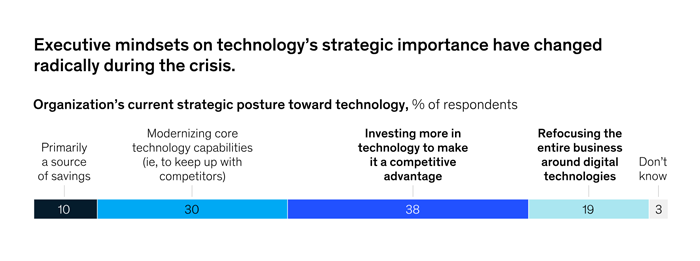 A custom software development solution may be a critical component of your effective digital transformation. After the global shift towards active technology adoption, custom software is no longer a business advantage – it’s essential for companies that want to survive, profit, and meet market and customer demands.
A custom software development solution may be a critical component of your effective digital transformation. After the global shift towards active technology adoption, custom software is no longer a business advantage – it’s essential for companies that want to survive, profit, and meet market and customer demands.
With that in mind, you can take your first step towards custom software development: assembling your ideas and defining what exactly can help your business — and how.
Here are two scenarios that business owners may face on the way to custom software launch:
As a business owner, you know your company, products, services, and team very well. And chances are, you already know what to build to achieve your goals.
Would you like your custom software solutions to serve your team or your customers? You may have identified multiple bottlenecks in the customer experience or in your team’s workflow. When starting down your path of custom development, you may want to focus on particular challenges and generate solutions for them.
In the table below, you can spot some of the most common challenges solved by apps both for internal corporate use and for consumers.
Custom software may help you handle two major types of business challenges: customer challenges and corporate challenges.
Customer challenges may be related to:
As you explore existing customer challenges, you may identify plenty of ways to boost your business and cater to customers’ needs better.
At the same time, you may focus on launching a custom solution for corporate needs:
Here, we would like to emphasize one of the essential benefits of custom software development: this approach allows you to get a product you want, a product that fully meets your needs and helps you solve customer or corporate challenges, a product that has a potential to open a new revenue steam for you and take your business to the next level.
You can generate ideas on how to meet the needs you identify in the most resource-efficient way. And that would be your next step towards building a custom software solution.
Inspired by examples of the most successful companies, you may want to revolutionize your target market or industry with an exceptional and unique solution that has the potential to change human lives. Although this approach may seem perfect, as it can open a channel to the blue ocean of opportunities, it’s risky.
Before you dive into custom software development, can you define what you want to build?
As Neil Eyar describes in his book Hooked:
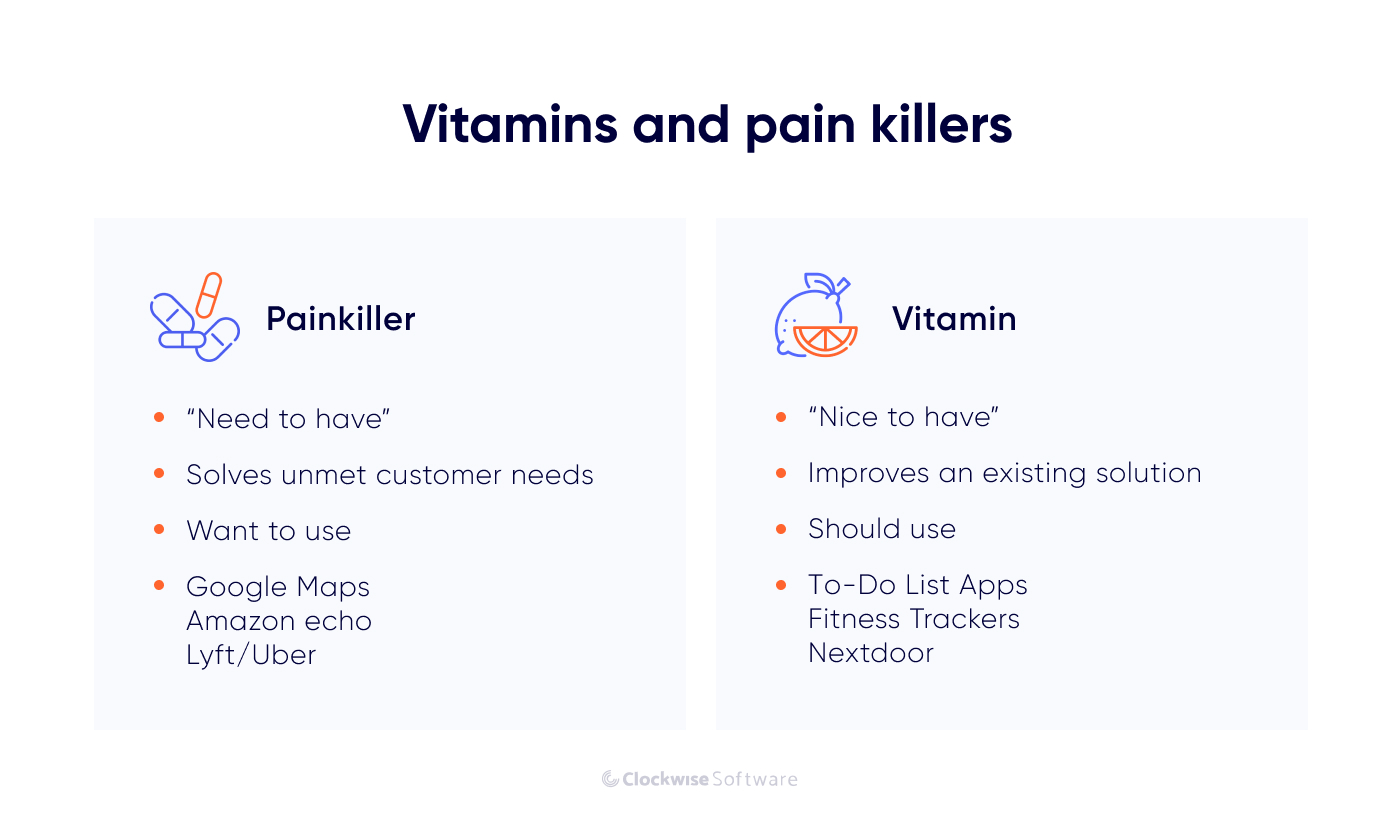
As you explore potential needs to satisfy with your app, ask yourself: Is it going to be a painkiller or a vitamin? According to surveys and analysis of investments, a painkiller app may be more profitable and successful.
Habit-forming products often start as nice-to-haves (vitamins), but once the habit is formed, they become must-haves (painkillers).
So while you’re just planning to enter the market with your product, it may be more cost-efficient, productive, and viable to focus on existing pains and come up with ideas on how to heal them.
But who do you need by your side to get this done?
We can name multiple startups that were born as a blend of an idea and the technical skills of two or three founders – including Facebook and Airbnb. However, in the case of custom software for business needs, you may face an important challenge: finding a custom development team to implement your ideas in an actual application.
For a business founder with an up-and-running company, the lack of a reliable engineering team may be a deal-breaker. Without a coding background, you simply can’t make an app. If you have a technical co-founder you can consult with, it gets a bit easier for you to move forward; if you’re all alone, you need to take drastic action to change that.
Your first option is to hire engineers internally.
In the local market, there may be a lot of skilled specialists looking for new opportunities. Just check local job platforms and see how many IT experts are looking for a job in your region.
But before you make your decision, there are four essential things you need to know about internal hiring:
Cooperation with external specialists may create this room for you.
In a remote-everything world, cooperation with external specialists is a flexible and convenient option. You can find a team with deep expertise in your niche working in Australia. You can meet a designer to create an impeccable visual interpretation of your app at Web Summit. You can delegate the whole custom software development process to a digital product development company that has years of experience building similar products, with a portfolio full of cool solutions for small and midsize businesses.
Outsourcing allows you to save time, cooperate with custom development agencies worldwide, and focus on your primary business goals — growth and development.
There are three major types of outsourcing:
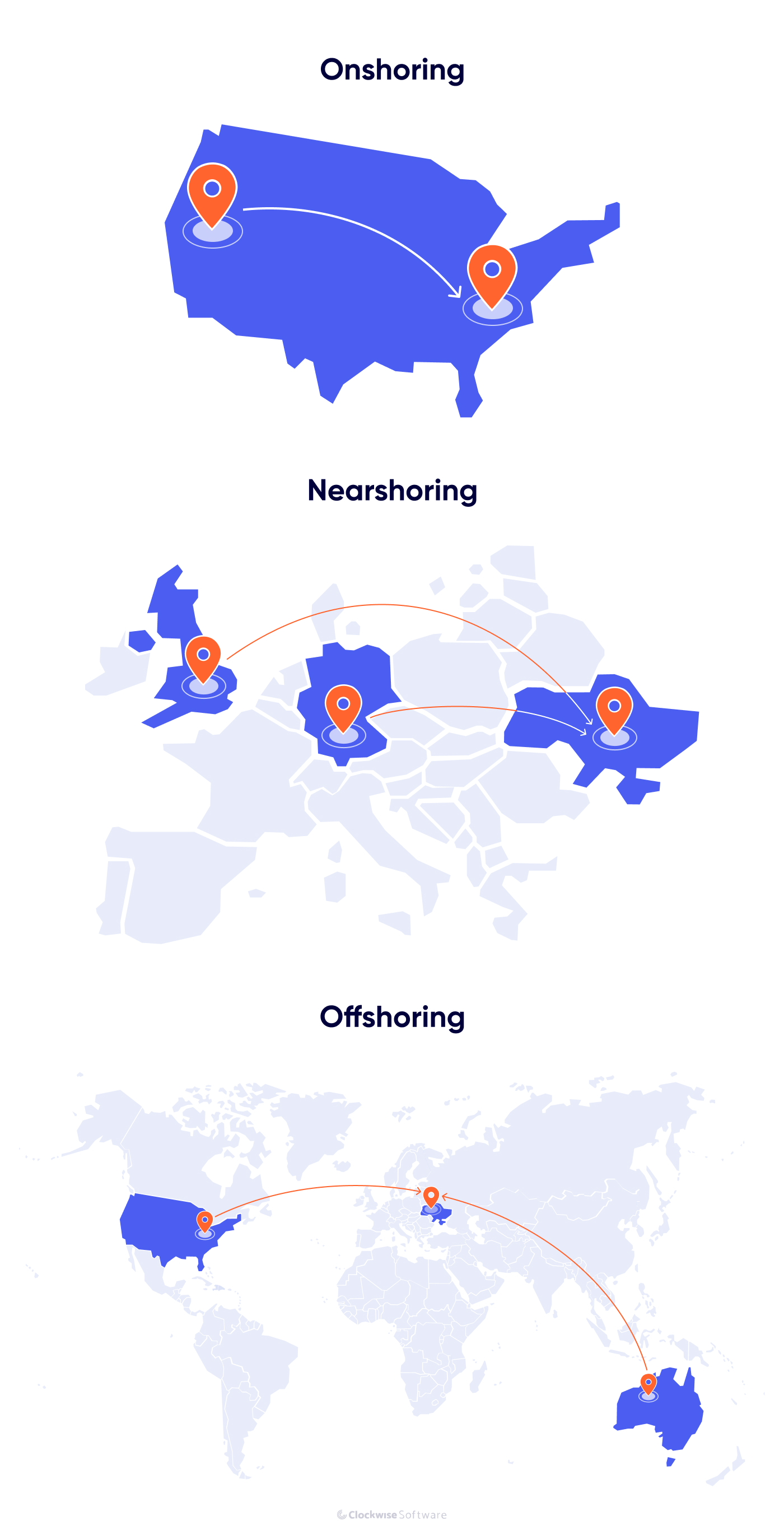
On our blog, we consider the peculiarities of each type of outsourcing in our post on the pros and cons of outsourcing software development.
One of the differences between these outsourcing models is the price for development services. Based on our experience, offshore custom software development may be the more cost-effective option for small and midsize businesses (SMBs).
Another prominent difference between internal and external hiring is that when hiring internally, you pay for hours a person works (i.e. a salary), while cooperation with an external custom development services provider means that you invest purely in software — you pay for a product. External partners take care of acquiring all resources needed to convert your ideas into software, while internal engineers work only on their assigned tasks.
And engineers are not the only team members you need to work with to launch an app.
We’ve already talked about hiring engineers, yet we didn’t mention how many experts you may need to start bespoke software development.
The answer varies depending on your needs, your company’s size, and the scope of tasks you want your development team to accomplish. There are one-person startups that attract attention and investments; there are also big product teams that file for bankruptcy after their product fails to find product–market fit.
In this article, we assume that you need a development team to build a minimum viable product (MVP software) — a product that embodies critical functionality to test an idea, with the aim to extend the MVP into a full-featured product.
Based on our experience, your team should include the expertise of eight experienced specialists:
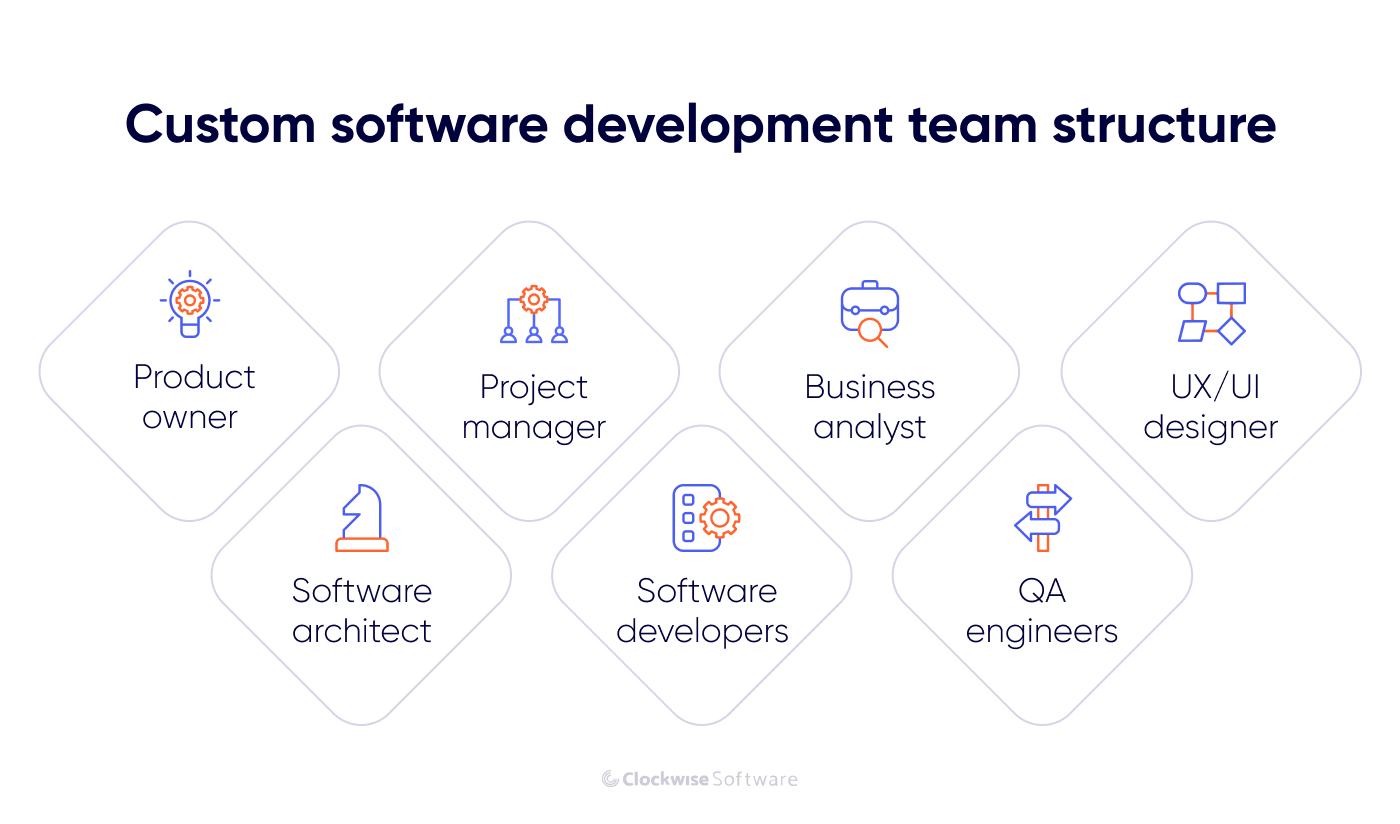
The product owner initiates product development and represents the end user’s interests in the development process.
The project manager is responsible for organizing, planning, optimizing, and controlling the development process. Typically, the project manager is an intermediary between the customer or product owner and the development team.
A business analyst is responsible for spotting significant product insights that may help you drive your business impact.
A user interface and user experience designer works on the visual side of your app, defining how your custom product will look.
A software architect designs the overall structure and the software system architecture, relations between different product components, and their mutual impact. In a development team, software architects make high-level technical decisions.
Software engineers employ tools, technologies, and their software development backgrounds to create the visual part of your app (frontend development) and everything that happens under the hood and makes the app work (backend development).
Test engineers implement quality assurance and quality control techniques to ensure your custom product meets all requirements. In your team, you need both software developers and test engineers.
You may play the role of product owner, or you can hire a dedicated person to handle communication with external development experts. In addition to the product owner, the software development team still needs six to eight more experienced specialists to deliver a high-quality custom product.
How will they do that?
All the magic between your initial request and successful product release is possible with software development and testing lifecycle techniques as well as cutting-edge tools and methods for efficient software development. But nothing’s possible without a preparation stage and a project discovery phase.
Thorough planning is the foundation of successful custom software development.
Earlier, you learned that you have several options to consider when choosing a service provider. While in-house hiring requires time and attention and may be more expensive than cooperating with an external custom software development company, it also limits you to your local market. Software development outsourcing may be more flexible and provide you with advantages:
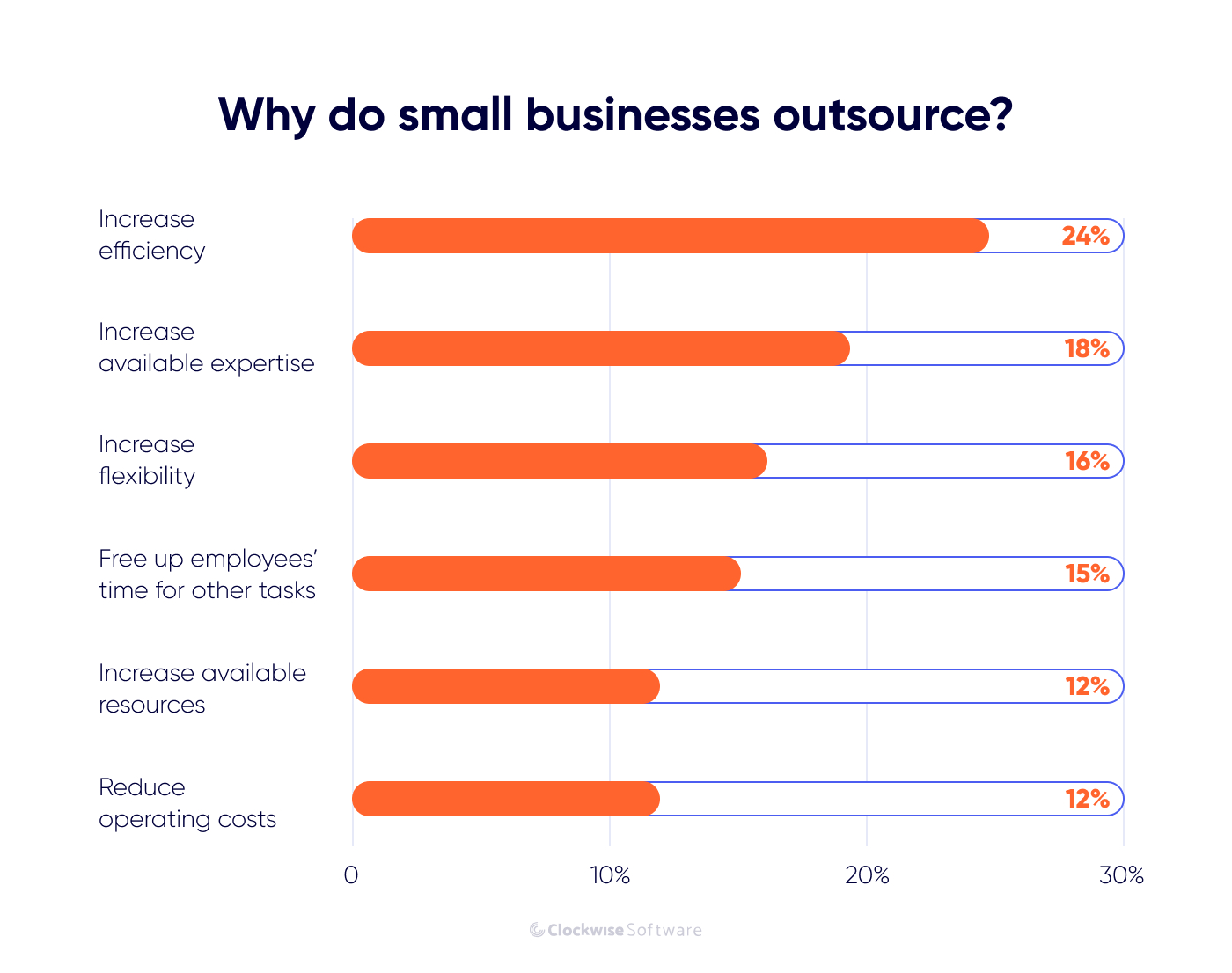
How can you choose a custom software development outsourcing company?
In our article about how to choose a software development partner, we take a close look at this topic. Here, we’ll provide several simple steps you can take to choose a company:
What about the location of your development team? In short, you can consider any destination as long as you can synchronize your working hours. Still, there may be some particularly beneficial destinations.
“Ukrainian agencies speak perfect English, understand all the current methodologies and are great to work with,” says George Berkowski in How to Build a Billion Dollar App.
The next step in custom software development is filling out a project brief.
A project brief questionnaire gathers critical initial information about your project. We have six key elements to our project briefs:
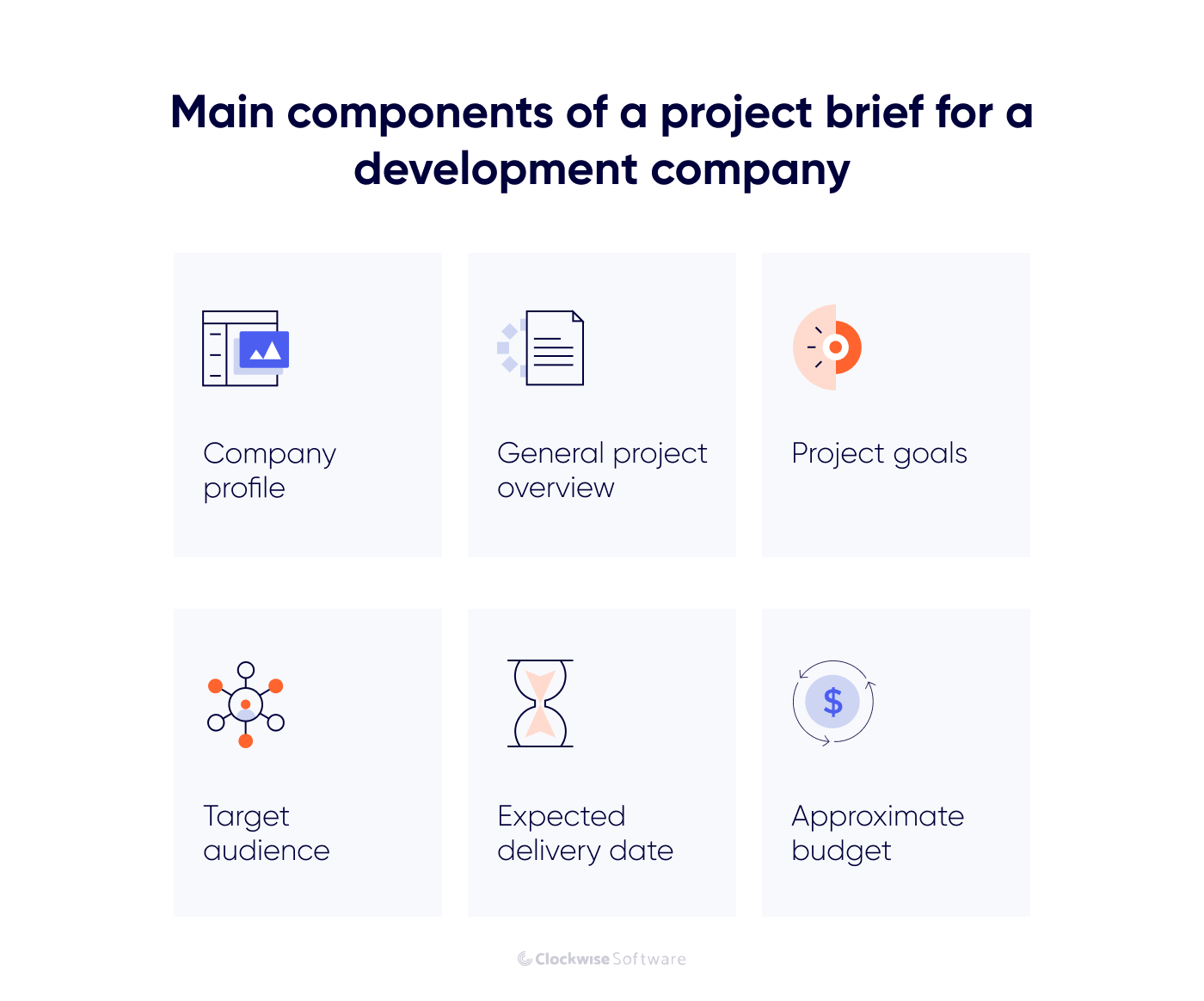
Filling out a project brief gives you two significant advantages:
If you’re not ready to fill out a project brief on your own, you can request help from a custom software development consulting provider.
What would you like to build?
Do you want to build ERP software or a mental health app? What type of product would you like to launch?
Custom software development provides advantages for businesses and may help you achieve your goals. However, before you start, you may want to ask yourself a single question one more time:
Should I really do this?
Similar solutions to your target problem may already exist; maybe you have a limited budget and are putting a lot at stake.
So should you really do this?
The project discovery phase allows you to validate an idea without investing in custom development.
If you don’t have a clear idea yet, if your idea lacks some details, or if there’s a chance to implement a better solution for the problem you’re focusing on, a project discovery phase will help you answer questions you didn’t even know you had.
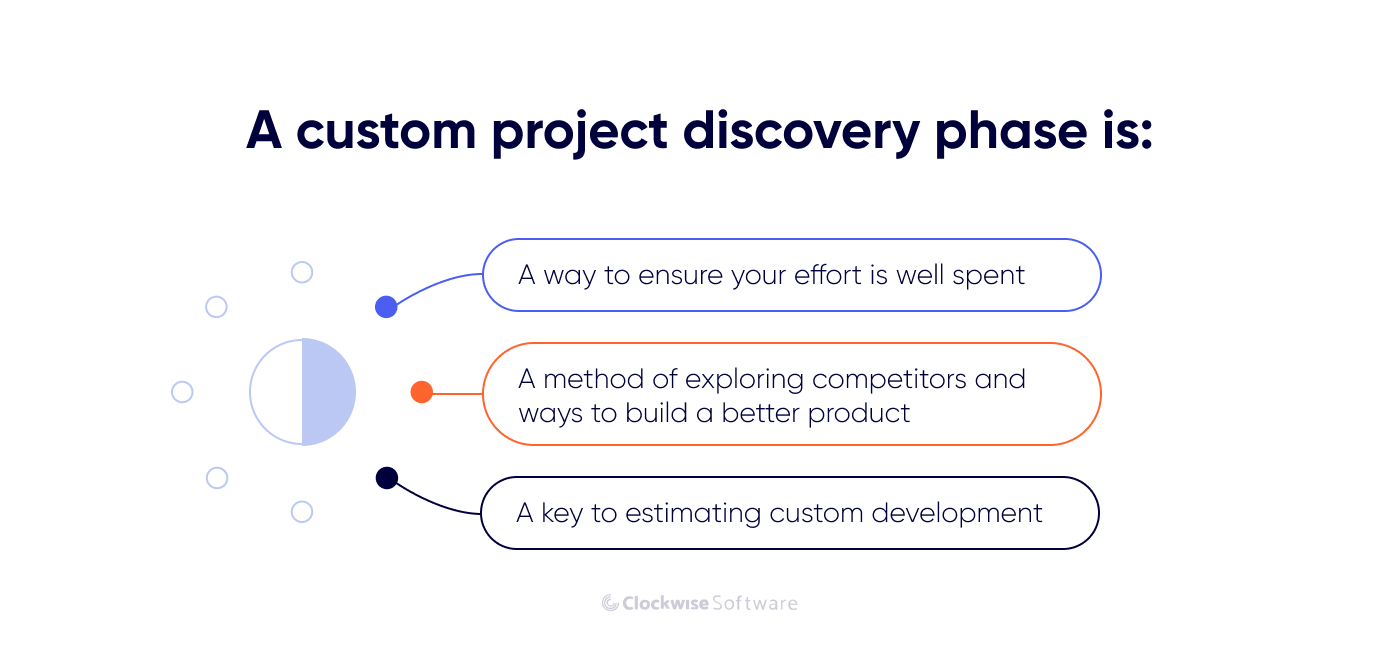
Development teams work on 10 to 20 deliverables during the software discovery process, and we’d like to draw your attention to some of them:
Now, your journey to custom development continues with the concept of the custom software development lifecycle (SDLC).
In our projects, we define five main stages of the custom SDLC that are tightly connected and organically flow into one another: software planning, which is based on project discovery; requirements gathering, review, and discussion; software design; development and testing stages; and deployment.
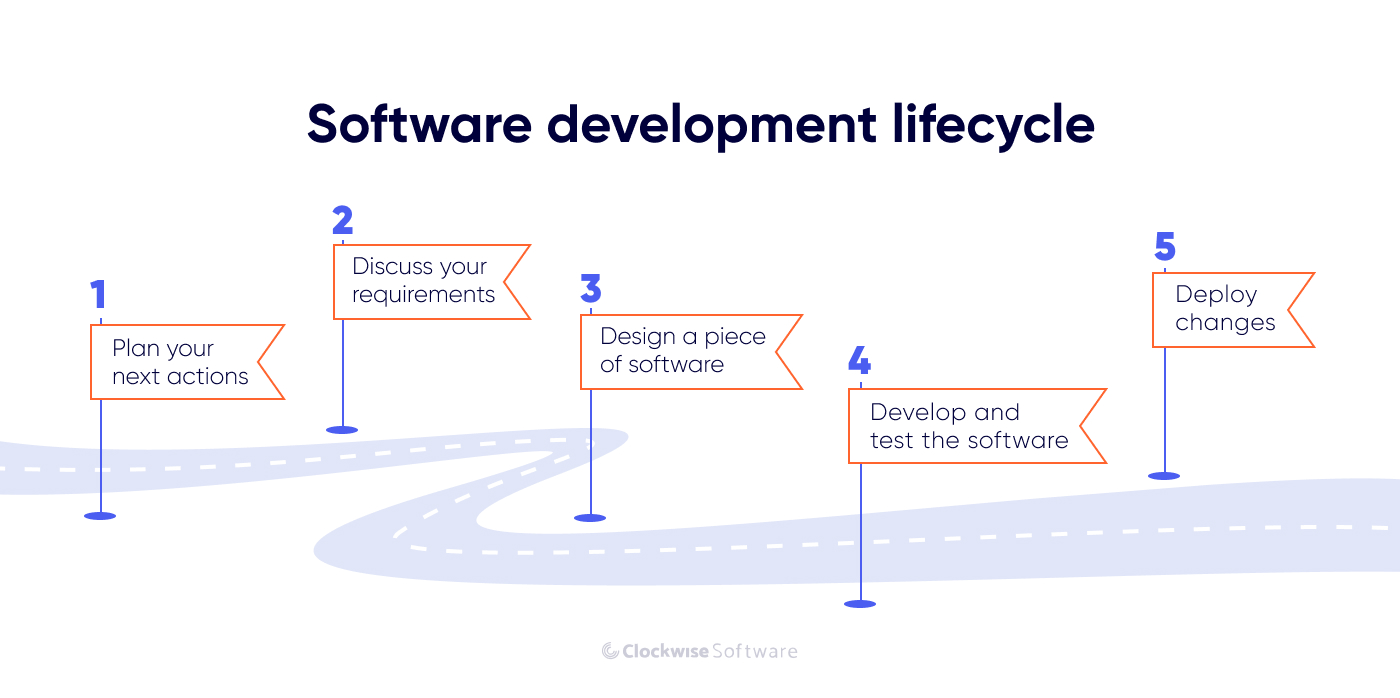
Where can you get when you don’t know where you’re going?
Careful planning is essential when going on vacation and is absolutely vital if you want to release business software. Planning overlaps with the discovery phase: you get all the deliverables you need to properly plan the development process during discovery.
What’s the general purpose of the product you want to build? Are you looking for ways to streamline your internal processes, enhance customer experiences, or create a brand-new product for your target audience? You answered dozens of questions when you filled out the project brief and passed through the discovery phase. Now, you should organize your answers in a way that lays the groundwork for the development process.
You’ll need to determine the resources you may need for ongoing iteration of your development process. How many developers do you need to contribute to this stage? How much do you need to invest in this project? Resource planning is an irreplaceable component of the development process.
How long does it take to create a planned piece of software? To track progress and ensure that the project stays on schedule, you and your team need to divide the scope of work into trackable milestones.
With a plan, you and your team can dive into the specific requirements of your custom software. This stage involves thorough discussions and documentation to ensure everyone is on the same page. And again, you can get this information during the project discovery phase.
Here are several essential things to focus on:
Engage with end-users to understand their preferences. This will help you shape the software’s features and functionality.
Functional requirements describe what the software should do, while non-functional requirements address aspects like performance, security, and scalability.
The project specification document outlines the software features, contains a user interface design, shows the database structure, and lists any third-party integrations. It serves as a blueprint for the development team.
The next stage is design. It focuses on creating a visual representation of the application and laying the foundation for its development.
User interface and experience designers explore similar products and current best practices to implement design elements users love in your product. These specialists create wireframes, mockups, and prototypes that define the software’s look and feel. The UI/UX design should prioritize user-friendliness and an intuitive interface, so at this stage, not only visual elements matter; a seamless user journey, an intuitive connection between screens and app components, and simplicity matter too.
Design is not how it looks like and feels like. It’s how it works.
Once the design is in place, the software development phase begins. Developers write the actual code and bring your vision to life. However, development is not just about coding; it also involves rigorous testing:
Developers use the project specification and design to write software code. The development process follows coding best practices to ensure maintainability and scalability.
Your development team may choose the right approach to implementing your idea based on your goal.
Web application development is the process of creating a web solution – the software users can open in a browser.
A typical American checks their phone around 150 times daily. Mobile screen time may even jump to a shocking six to seven hours per day. Thus, you might want your application to be accessible on mobile devices.
In this case, your development team uses a native or hybrid development approach. A native approach is developing custom software for a particular mobile platform – iOS or Android. A hybrid approach is building a mobile app that is platform-agnostic and can run on any mobile device. You may consider hiring React native developers for hybrid development tasks.
QA engineers thoroughly test software to identify and resolve errors. This includes functional testing to ensure the software meets its specifications, as well as performance, security, and other types of software testing methods and approaches.
The development and testing phases are iterative. As engineers identify and fix issues, the software is refined.
The final stage of the custom software development lifecycle is deploying the software to its target environment — the cloud or physical servers and application stores — and making it available for use. This stage involves two important steps:
A development team creates a deployment plan that outlines how the software will be moved from the development environment to the production environment. This includes migrating data, setting up servers, and configuring the software. For cloud-based applications development, this step requires extra attention: a development team has to choose the most suitable cloud provider and get acquainted with the rules and regulations of deploying your software to this cloud.
To help users adopt your app, provide training and documentation. A well-designed user training program can significantly improve user adoption and satisfaction.
The custom software development lifecycle is a structured and iterative process that takes your business from planning and requirements gathering to design, development, testing, deployment, and beyond. While you may not be a technical expert, clearly understanding these stages will help you effectively collaborate with your development team.
Software projects may differ in terms of the scope of work, chosen technologies, critical functionality, and many other factors. Some projects may involve eight IT experts, and other projects are impossible to implement without a team of at least 20 specialists.
Every idea is unique, and so is every implementation.
Based on the specifics of your idea, you and your engineering team may choose from the most popular software development methodologies:

Development teams may tune these methodologies, mix their elements, or switch from one to another to increase efficiency and track the method that works best. Along with that, they may implement a variety of frameworks like Scrum or Kanban to improve performance, follow Continuous Integration / Continuous Delivery (CI/CD) methods, and implement DevOps best practices to boost development velocity and software quality.
After deployment, software requires ongoing support and maintenance to address issues, make updates, and ensure that it continues to meet your business needs.
Becoming a ten-million-dollar app and cementing your product–market fit is about developing product features quickly, testing them, measuring them, adopting the best ones and then repeating the process.
Software development companies barely draw attention to the fact that the software development process is indefinite — it lasts as long as you want your product to thrive and bring you benefits.
Here at Clockwise Software, we believe it’s essential to emphasize the necessity of continuous discovery and continuous development.
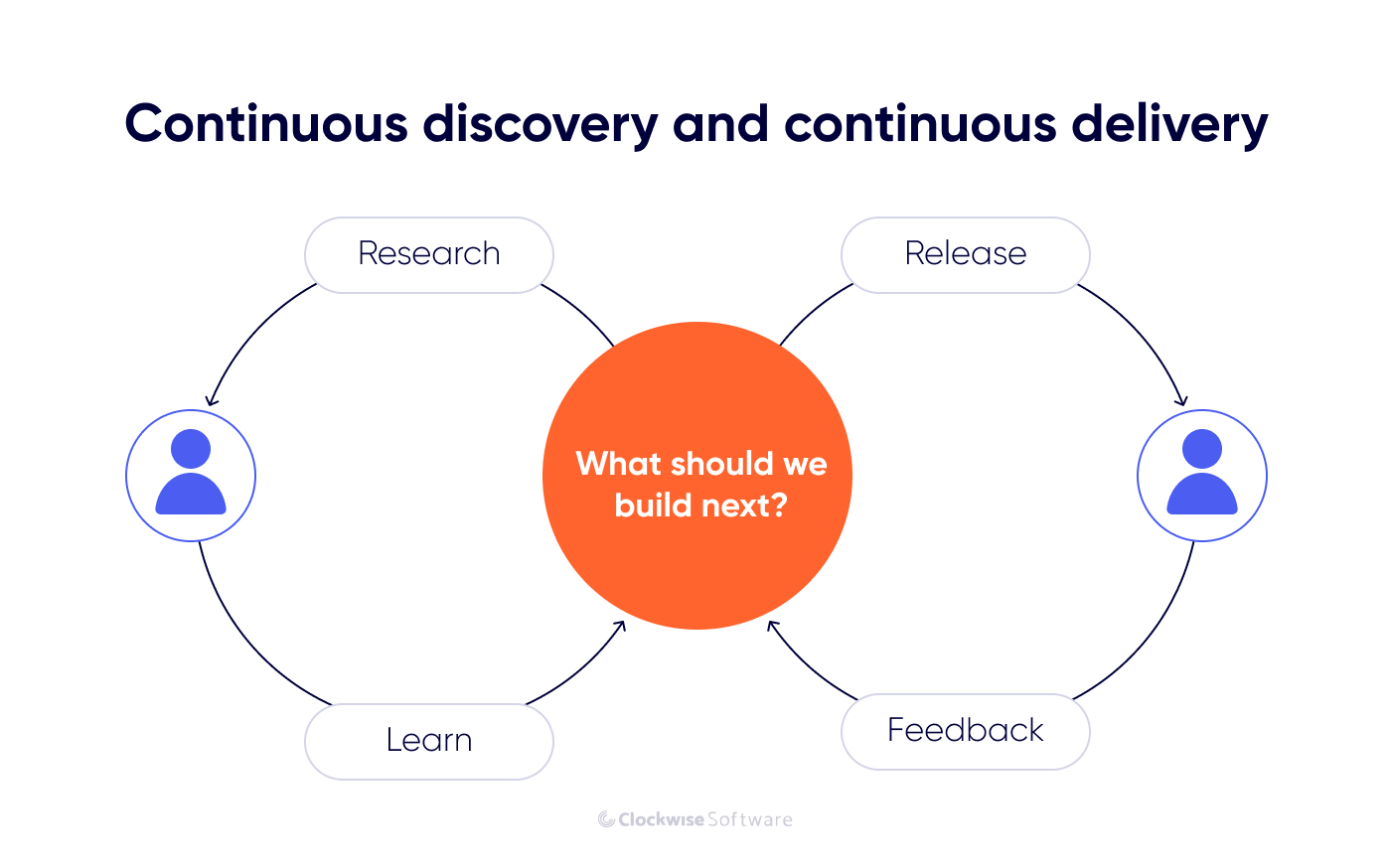
Discovery isn’t a one-time activity. A digital product is never done. It can and should continue to evolve.
Implement monitoring tools that allow you to track your software’s performance and user behavior. With this data, you can take steps to optimize the application, fix any emerging issues, and add new features as needed.
At the same time, performance monitoring is your chance to optimize your software’s cost. For example, your development team may decide to switch from the feature-rich AWS to the more cost-efficient Google Cloud if they notice that certain AWS functionality isn’t necessary for your project. They may notice that a single-tenant architecture approach isn’t enough for you and start migrating to a multi-tenant software architecture.
Performance monitoring is a source of data you can use to migrate to more suitable subscription plans, replace paid solutions with free platforms as soon as you can, and take action to speed up your app and improve the user experience.
All code ever written will eventually turn into technical debt.
To test your custom software app development idea with high-quality MVP software, your team may take shortcuts and go with quick solutions. This gives a lot of advantages at the start of development: when you quickly validate your idea, you can either move on with it and enhance it or fail fast, modify your vision, and test a new product idea.
However, the simplest solution may stop fitting your application with time. It will result in slower delivery, technical issues, and challenges for developers. Thus, another thing you should know about the life of an app after its deployment is that it will include some work with technical debt.
Founders across multiple industries claim they’re starting to implement language learning models (LLM). and generative AI solutions in their companies, products, and services.
 Our team strongly believes in the (almost) almighty AI and the perks it can bring to your business. We have worked with a variety of LLMs and generative AI tools and have implemented them in both our internal products and our customers’ solutions.
Our team strongly believes in the (almost) almighty AI and the perks it can bring to your business. We have worked with a variety of LLMs and generative AI tools and have implemented them in both our internal products and our customers’ solutions.
Integrating an AI tool into your custom product isn’t a challenge for a skilled development team. At the same time, it can help you join the leaders in your market and industry, streamline your business processes, better cater to end users’ needs, and ensure you stay ahead of the competition with the most advanced technologies.
When planning to build custom software, you need to know what budget it requires. To increase your awareness, we have prepared some rough estimates of a custom software development cost based on our experience:
However, the figures for your project might be slightly different. Many factors impact the investments needed to build a product. The cost of product development may vary depending on the type of solution you want to build, the cooperation model you choose, and how much work your team needs to complete. Thus, to estimate the cost, you need to consider all these factors. You can learn more about them below.
Custom web software development costs vary based on three main factors:
Who will work on your project directly impacts the product development cost.
What cooperation model do you prefer? You may want to gather an in-house team. In this case, you need to prepare yourself for expenses related to the recruiting process, benefit packages, and regular salary payments, regardless of whether your product idea works.
Or, chances are, you already have internal engineers and are now only looking for Dedicated development team services. This cooperation model may be a cost-effective option if you need a few additional specialists with specific skills that your internal engineers lack. However, if you need a whole new team dedicated to product development, it will be more beneficial in terms of cost and cooperation efficiency to outsource the development to an external team rather than use Dedicated development team.
When choosing software development outsourcing or Dedicated development team, the location of your specialists may also impact your product cost. How much does it cost to outsource software development? Hourly development rates vary across countries. For example, according to a recent statistic on software development pricing shared by Clutch, in the US, Australia, and Canada, development prices start at $100 an hour. In contrast, in South Asia, app development costs may start at $20 an hour. If you choose to outsource app development to Ukraine or any other European country, expect the hourly development rate to start at $50.
The size and composition of your team can also affect the final cost of your software development project. The more complex the product you want to build, the more people and diverse expertise you will need to finish it in a reasonable timeframe, and therefore, the more you will pay to develop your product.
What work should be done to build a product you want?
You may want to start with a discovery phase to validate your idea and plan your further development. This phase requires time and effort from your team, as well as additional expenses from you. Depending on the deliverables you want to get in this phase, the scope of work and cost may differ. You can check our project discovery packages and their price to understand better how the scope of work in this phase impacts the price.
After the discovery phase, you might start building an MVP. Let’s say you plan to build a custom ERP system and turn it into a SaaS product. If you search for some guides on how to build a SaaS product, you will see that this type of software takes much effort to deliver. Cloud infrastructure, various features, the potential for white-labeling software, and many other specifics of SaaS products may impact the scope of work — and the more work to be done, the higher the custom software cost.
Additionally, the specific features you need to develop for different types of software may impact the cost. For example, custom logistic software will have entirely different functionality than a custom marketing analytics platform and require a different amount of time and effort from the team to complete the work.
Each requirement you have in mind may impact your custom software development cost.
Would you like your software to only use commercial third-party APIs? That may increase the development cost.
Do you plan to implement generative AI in your software? Getting access to pre-built AI models or building a model from scratch will require different investments (both money and effort), changing your software development cost.
What platforms do you want to target? For example, you can build a cross-platform application to target multiple platforms using a single codebase. Or you can opt to develop separate native apps for Android and iOS. Make sure to include the hours needed to finish this task in your estimates. The custom app development cost will entirely depend on your choice and requirements.
As you can see, any project detail can impact the cost of software development. Additionally, the average cost of custom software development services will vary depending on the service provider.
We can provide you with a more accurate, data-driven estimate if you share details of your idea with us.
What else can help you avoid wrong estimates and find the most cost-effective software development option? Below, you can find some useful tips.
It may be very frustrating to realize in the middle of the process that the cost to develop software will be higher than estimated at the start. Wrong estimates may even force you to stop development if you can’t allocate additional budget.
With experience developing various software from scratch, we know how to approach software development cost estimates to get the most accurate figures. We also always try to find the most cost-effective option for our clients and consider possible ways to reduce software development costs. Here are a few recommendations that help to avoid wrong estimates and unreasonable expenses:
Focus on expertise when hiring. While pricing and reputation may be important factors when choosing app development partners, you should also pay attention to their portfolio and expertise. If a company has experience building the type of software you want or has worked on projects in your niche, it may be your best choice for cooperation. In this way, you can ensure that your team knows the specifics of developing a product you need and expect fewer issues after its launch that would require additional expenses.
Pay attention to the pricing model. There are several custom software development pricing models that suit different types of projects and, if chosen correctly, can help you avoid additional expenses. For example, if you build a simple web app, have well-defined project requirements, and are sure there will be no changes, you can opt for the fixed-price model, which allows you to define a fixed web app development cost of the entire scope of work at the beginning.
Or, if you expect your project requirements to evolve over time and need some flexibility, you may opt for the _time and materials model _in which you pay only for time and resources spent on your project development. This pricing model suits most custom software development projects, whether it's a CRM system, location-based application, or data visualization software, as it supports the agile approach to development and allows you to plan your development expenses from month to month, depending on the time you want your team to spend on your project.
Share as many details as possible in a project brief. With a detailed project brief, a development team can better understand your requirements, as well as the time and budget limitations, and take them into account when estimating the cost of custom software development. Thus, you can get more accurate estimates that are aligned with your preferences.
Don’t neglect the project discovery phase. We’ve mentioned earlier the numerous benefits project discovery brings, including the validation of your idea feasibility, a well-defined scope of work, and detailed project documentation. Thus, although conducting a project discovery requires expenses, it can save you from investing in developing a wrong product and spending a considerable amount of money on reworks.
Custom software development may bring numerous benefits to your business. It allows you to build software that works exactly how you want it to work. Instead of trying to adjust your processes and offering off-the-shelf tools, the custom approach allows you to implement a customer-centered approach, flexibility, and scalability features to your whole company.
At the same time, tailor-made software may be your key to increasing revenue through monetization and external funding.
The entire process spins around answering four main questions:
With clear answers to these questions, you can move forward with your idea, convert it into a lovable product, and improve your company, reputation, and revenue.
